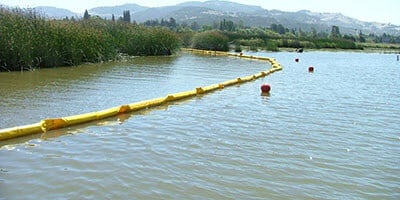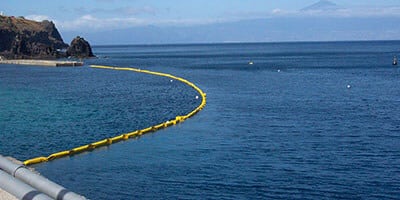TYPE 2 TURBIDITY CURTAINS
Type 2 turbidity curtains or silt curtains, as they are sometimes called, are durable curtains that are suitable for mild currents, waves, and wind. These barriers are designed for the control of silt and sediment during marine construction and dredging. They are available in impermeable and permeable options. American Marine, a division of Elastec, has been manufacturing quality turbidity curtains since 1967. Read our Frequently Asked Questions.

SiltMax Type II DOT

Type II FastWater Screen
Clean Water Act and National Pollution Discharge Elimination System (NPDES)
The implementation of the Clean Water Act and Phase II of the National Pollution Discharge Elimination System (NPDES) has led to major changes in operating procedures for the industrial sector. According to the NPDES, sediment and debris from sites require MS4 operators to develop and implement a stormwater management program to reduce the discharge of pollutants in discharges from the MS4 to the maximum extent practicable, and to meet other permit requirements as determined appropriate by the permitting authority.
The implementation of the Clean Water Act and Phase II of the National Pollution Discharge Elimination System (NPDES) has led to major changes in operating procedures for the industrial sector. According to the NPDES, sediment and debris from sites require MS4 operators to develop and implement a stormwater management program to reduce the discharge of pollutants in discharges from the MS4 to the maximum extent practicable, and to meet other permit requirements as determined appropriate by the permitting authority.
Requirements for suspended particulates/turbidity
According to the NPDES, “Suspended particulates in the aquatic ecosystem consist of fine-grained mineral particles, usually smaller than silt, and organic particles. Suspended particulates may enter water bodies as a result of land runoff, flooding, vegetative and planktonic breakdown, resuspension of bottom sediments, and man’s activities including dredging and filling. Particulates may remain suspended in the water column for variable periods of time as a result of such factors as agitation of the water mass, particulate specific gravity, particle shape, and physical and chemical properties of particle surfaces.” To control these particulates, the NPDES recommends using silt screens or other appropriate methods to confine suspended particulate/turbidity to a small area where settling or removal can occur.
Together, the Clean Water Act and NPDES have encouraged major product development by Elastec in order to keep up with our customers’ needs and allow them to remain in compliance with these regulations. View DOT requirements by state.
TURBIDITY CURTAIN QUESTIONNAIRE
In order that we may recommend the best Turbidity Curtain for your project, please provide the following information. We have included some questions that will help us better understand your needs. Please answer as many as possible. If the flow rate is high, Elastec can provide modeling data to determine anchor spacing and feasibility of systems.
Turbidity Curtain Frequently Asked Questions
Are turbidity curtains in stock and ready to ship?
Account for lead times of a few weeks to produce a curtain in the factory. Most curtains will be custom and not off the shelf.
How much curtain do I need for my project?
Account for the anchor rodes. Best anchorage for turbidity curtains is a 5:1 slope. In 10′ of water you will have 50′ of anchor lines on one or both side of the curtain. Possibly into the work area.
How important are water conditions?
Water conditions (wind, wave height, flow rate) are important to ensuring proper anchorage is being used. Account for pull from intake structures, ice, debris, and wake from vessels.
How are deeper curtains affected by tidal flow?
The deeper the curtain, the calmer the conditions need to be. A curtain 30′ deep in 2 knot tidal flow will only have an effective depth of 13′ and will be difficult to keep in place even with heavy anchoring.
How deep should my curtain be?
Curtains should not touch the bottom. Flow of water is not going to be stopped by a fabric curtain. You cannot sand bag or add additional weight to the bottom of the curtain to keep it down. This will tear the curtain. Also, in calm situations, sediment can build up on the curtain making it impossible to retreive when the work is finished. Curtains will perform better the more parallel they are to the flow.
